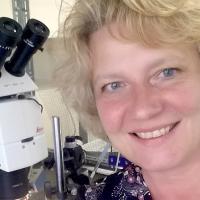
Agroecology Reading time 5 min
Emmanuelle Jacquin-Joly, connecting sense of smell and the imagination
Published on 01 December 2019
With some 80 publications in international scientific journals, no fewer than 12 chapters of books and two patents to her name, it is clear that Emmanuelle Jacquin-Joly, head of the Sensory Ecology Department at the Institute of Ecology and Environmental Sciences of Paris (1) has had an illustrious career.
On her quest to better understand the physiological and molecular mechanisms behind the chemical communication between insects and odours, Emmanuelle wants to eventually figure out how to modify olfactory behaviours and develop new biocontrol methods for harmful pests. She's (almost) lost count of her victims, which include moths such as crop-ravaging noctuid moths, disease-spreading haematophagous bugs, silkworms and fruit flies.
Odorous chemicals
Where passion meets duty
Emmanuelle first became interested in sex pheromones, the chemical substances produced especially by female moths to attract males for mating. She investigated the biosynthesis and regulation processes before looking at olfactory receptor signal mechanisms, a promising field of research at the time for understanding how to alter insect behaviours. Using innovative transcriptomic approaches, she identified the first olfactory receptors in noctuid moths. She then turned her attention to the entire chain that captures and transports odours in insect antennae, from the carrier proteins to the enzymes that break them down.
As they gained insights into insect olfactory communication, Emmanuelle and her team discovered new paradigms, such as sex pheromone recognition in immature caterpillars, which used pheromones to find food rather than for mating. This opened up a huge range of potential areas of research.
Would choosing one opportunity mean passing up another? Not really. For Emmanuelle, deciding to focus on insect olfactory receptors meant combining passion and duty to align the team’s research with INRA’s scientific objectives. From neurobiology to agronomy, genes and behaviour, identifying and characterising olfactory receptors seemed to her to be a major priority because they are relevant targets for new or optimised pest control strategies.
Insects adapt to their environment
In recent years, Emmanuelle and her team have created functional approaches to understand the role of these olfactory receptors in the choices insects make. She has developed extensive expertise along the way: identifying the first pheromone receptor in codling moths or the Spodoptera littoralis cotton leafworm to determining the first repertoire of olfactory receptors and odours that activate them or demonstrating the effectiveness of the CRISPR/Cas9 genome editing technology in cotton leafworms. Her skills have led to multiple collaborations in France and abroad and has piqued the interest of biocontrol professionals.
Because the evolution of the chemosensory system in insects could drive their environmental adaptation, Emmanuelle has recently began looking at how it contributes to changing hosts, adapting to anthropic pressures and invasions with a view to better predicting these phenomena. Genomics and bioinformatics are precious allies in this work. In 2017, the genomes of the Spodoptera and Helicoverpa moths were sequenced and analysed, revealing remarkable expansions in their chemosensory genes, likely linked to these voracious insects’ polyphagous feeding habits.
Research, teaching and training: this researcher has more than one trick in her bag. And because pests are not bound by borders, her perspective is more international than ever. Whether she is participating in projects, consortiums, networks or conferences, her expertise is greatly appreciated. Although she loves encouraging her colleagues or leading and managing research projects, she still finds time to work in the lab and in the field, making this quote by entomologist Jean-Henri Fabre her own: “I learned about these wonders by reading; but seeing them with my own eyes, and being able to do experiments, is truly something else.” (2)
(1) IEES Paris (INRA, CNRS, Sorbonne University, IRD, UPEC, Université Paris Diderot).
(2) Souvenirs entomologiques is a series of texts by entomologist Jean-Henri Fabre (1823-1915).
- 52 years old
- Since 2014: Head of the Sensory Ecology Department at the Institute of Ecology and Environmental Sciences of Paris – IEES Paris (INRA, CNRS, Sorbonne University, IRD, UPEC, Université Paris Diderot)
- Since 2006: research director – INRA
- 1994: research scientist – INRA
- 1989: research assistant – INRA
- 2005: Authorisation to conduct research – Université Pierre & Marie Curie, Paris
- 1992: PhD – Institut national agronomique Paris-Grignon and Cornell University (USA)
- 1992: Master’s in Biochemistry and Protein Science – Institut Pasteur, Paris
- 1989: Agricultural engineer, specialised in crop protection – Institut national agronomique Paris-Grignon
